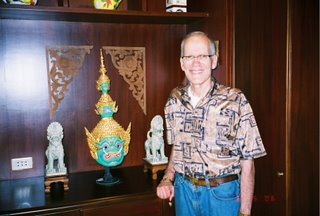TPO is a Bright Exception to the Dismal Bangkok Classical Music Scene
 |
| Hungarian duo guitarists, the Katona Twins, meet the public after their performance with the TPO. |
MACM Hall. College of Music Mahidol University. Nakompathom, Thailand. January 26, 2013. The classical music scene in Thailand’s
capital city has been deteriorating over the years and can only be described as
dismal. The decreasing number of events
are held in mostly makeshift venues, before small, appreciative but ill-behaved
audiences of both Thais and foreigners, with uneven and irrational ticket
pricing, and performances that are often not representative of the abundant
great talent and superb teaching that exists in the country. An exception to this discouraging picture is
the Thailand Philharmonic Orchestra, which maintains a full season of exciting
programming, which it performs in an auditorium which was specifically designed
as a concert hall. The members of the
orchestra are comprised of both faculty members and students at the College of
Music of Mahidol University, under an excellent permanent conductor, Gudni
Emilsson, whose tenure has shaped the sound and performance standards of the
orchestra, and several excellent guest conductors. This orchestra sounds good.
“From Piazzolla to Sibelius,” is a good example of a typical
TPO program. It began, as usual, with an
orchestral arrangement of a fast tempo traditional Thai song, which usually
sound similar to a Boston Pops arrangement of an American standard. It’s a nice way to begin a program. I wish that the TPO would make a CD of these
arrangements because many of them would be worth repeated hearings.
A guitar duo from Hungary, the Katana Twins, played two 20th
century works for two guitars, the Double Concerto for two Guitars and
Orchestra by the Argentinean composer Astor Piazzolla, and Concerto Madrigal
for two Guitars and Orchestra by the Spanish composer Joaquin Rodrigo. Both works were unknown to me and, I suspect,
most of the audience, but they were interesting to hear and sometimes haunting. Confidentially played by these excellent
soloists, they found sympathetic support from the orchestra lead by Italian
guest conductor Alfonso Scarano. I
especially liked the Piazzolla, which, scored for strings and a few winds,
showed just how good the TPO’s strings are, which often get crowded out by the
orchestra’s brass. The encore was an arrangement
by the twins of a well-known Vivaldi sonata.
Although its resemblance to the original Vivaldi was unrecognizable, it
didn’t have to be: Liszt was a master of
taking an opera or orchestral fragment, and using it to create a work which
stood by itself and paid only lip service to its origin.
The second half of the program was devoted to a passionate
performance of Symphony No 1 by Jean Sibelius, a work I haven’t listened to in
many years. During his long lifetime,
Sibelius was a controversial composer.
“…he was lionized in America and dismissed as a kitsch composer in the
taste-making Austro-German music centers.”
(“The Rest is Noise,” by Alex Ross, p. 171.) His Symphony No. 1 shows that he is much more
than a composer of nationalistic works (e.g., Finlandia) from small nations and
one can hear a lot more in this sometimes strange symphony than forest murmurs
from Finland. Unfortunately for this
otherwise excellent performance, the score made clear the major problem faced
by the TPO---a lack of strings---which results in the brass overpowering the
strings and unbalancing the orchestra, which no amount of adjusting can totally
cure. More string players please.



0 Comments:
Post a Comment
<< Home